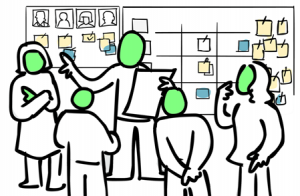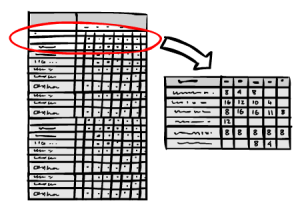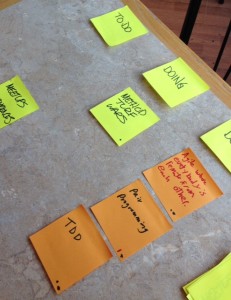
Inspired by artwork by Pictofigo
As an executive, you will be faced with the choice to do the pivot (if you can) or persevere (if you have no other choice). This will lead to a series of “bets”. You lead with a hypothesis that the things you change will allow you to operate at pre-event levels. But, how long will it actually take for you to validate your hypothesis and have a bet pay off with pre-event levels? If you run out of time to figure it out or run out of bets you can place, then you either lose your standing in the market or worse risk going out of business.
Regardless of the organization or institution, there will always be dependencies. The larger the organization, the greater chance of the existence of dependencies.
This template is available for download from Tableau Public
I keep getting asked, does Jira Align support Flow Metrics, as defined in the Flow Framework and SAFe? The short answer is yes. If you believe these metrics will help unlock the potential of your teams, use this community post to see working examples of Tableau reports I have created using Jira Align and Enterprise Insights.

Inspired by artwork by Pictofigo
I don't personally own any patents but perhaps I should reconsider. If you own a patent, you can sue people for infringing on it. You don't have to actually create anything valuable. You just sue people and make money. You'd think it sounds crazy but it's happening! People known as "patent trolls" are buying patents for the sole purpose of suing others. One guy in Texas owns a patent and sent out 9,000 letter demanding $1000. The violation? He claimed to have patents that cover any networked "scan-to-email" function.
On December 8, Penn State is looking to sell a few patents it owns. One of the patents for sale is US Patent No. 8,442,839, entitled "Agent-based collaborative recognition-primed decision-making." The lead inventors are PSU professors John Yen and Michael McNeese. The patent essentially describes different ways that people work together to solve a problem.
Collaborative agents for simulating teamwork (CAST) are provided with a recognition-primed decision (RPD) model, thereby enhancing analysis through linking and sharing information using knowledge and experience distributed among team members. The RPD model is integrated within a CAST architecture to the extent that agents can proactively seek and fuse information to enhance the quality and timeliness of the decision-making process. The approach, which is applicable to both human assistants and virtual teammates, can approximately track human's decision-making process and effectively interact with human users...
So, at the low cost of $5,000, you could theoretically buy the patent and then sue anyone using a collaborative agent (could be software or even physical boards) that helps people make better decisions and share information with team members. Essentially, you could require all Agile teams to pay a licensing fee.
Should Agile Alliance, Scrum Alliance, PMI, or some other body buy this stupid patent?
Should VersionOne, Rally, and Microsoft join forces to share this patent?
What would you do?
Image: Pictofigo
 Over the last few years, I've worked with numerous teams. One thing they all struggle with is backlog grooming. They all know they need to do it. Unfortunately, they all seem to struggle with when to do it or who should do it. The most interesting struggle with backlog grooming happened two years ago. The "story time" meetings took place at the beginning of a month-long sprint. The manager stated, the work to be completed and delivered during that sprint had to be refined within the same sprint. This helped explain why the team thought they needed month-long sprints. When I asked why they would try to refine work the first two weeks of the sprint and then complete that work the second two weeks, you know what their answer was? "It said to do it like that in the Scrum Guide!" After I clarified their misunderstanding, we established a cadence to continuously mature the backlog. A rotating selection of people would participate in the scheduled meetings. We would reserve capacity from each sprint to get that work ready for future sprints. The team was able to shorten their sprints to 2 weeks. They more than doubled their delivery rate without increasing defect rates. With that as an example, over the last few years, I have evolved my practice of backlog grooming. Let’s look at some key dates in the evolution of backlog grooming.
Over the last few years, I've worked with numerous teams. One thing they all struggle with is backlog grooming. They all know they need to do it. Unfortunately, they all seem to struggle with when to do it or who should do it. The most interesting struggle with backlog grooming happened two years ago. The "story time" meetings took place at the beginning of a month-long sprint. The manager stated, the work to be completed and delivered during that sprint had to be refined within the same sprint. This helped explain why the team thought they needed month-long sprints. When I asked why they would try to refine work the first two weeks of the sprint and then complete that work the second two weeks, you know what their answer was? "It said to do it like that in the Scrum Guide!" After I clarified their misunderstanding, we established a cadence to continuously mature the backlog. A rotating selection of people would participate in the scheduled meetings. We would reserve capacity from each sprint to get that work ready for future sprints. The team was able to shorten their sprints to 2 weeks. They more than doubled their delivery rate without increasing defect rates. With that as an example, over the last few years, I have evolved my practice of backlog grooming. Let’s look at some key dates in the evolution of backlog grooming.
2005: "grooming the product backlog" is mentioned by Mike Cohn on what is now the Scrum Users Yahoo Group;
I always have teams allot some amount of time to “grooming the product backlog” to make sure it’s ready for the next sprint.
2008: A formal description of "backlog grooming" is given by Kane Mar, under the name Story Time, and recommending it as a regular meeting
I call these meetings “Story Time” meetings....Although they are not a formal part of Scrum, I’ve found that Story Time greatly improves project planning and reduces confrontational planning meetings, which are all too common for many teams. A Story Time meeting should be held at the same time and location every single week and involve the entire team, including the Product Owner and ScrumMaster. The sole intention of these weekly meetings is to work through the backlog in preparation for future work.
2011: The practice of "backlog grooming" is called "backlog refinement" and promoted to an "official" element of Scrum with its inclusion in the Scrum Guide
Product Backlog refinement is the act of adding detail, estimates, and order to items in the Product Backlog. This is an ongoing process in which the Product Owner and the Development Team collaborate on the details of Product Backlog items. During Product Backlog refinement, items are reviewed and revised. The Scrum Team decides how and when refinement is done. Refinement usually consumes no more than 10% of the capacity of the Development Team. However, Product Backlog items can be updated at any time by the Product Owner or at the Product Owner’s discretion.
2014: Derek Huether from LeadingAgile evolved the practice of backlog grooming with one of his clients, to allow the practice to work better at scale, calling it a "Progression" workshop.
When operating at scale, my client deals with different problems than a standard Scrum team. They're dealing with separate lines of business. They're dealing with multiple delivery teams for each line of business, to include external vendors. They're dealing with a portfolio roadmap that has annual plan items and budgets. Our strategy encapsulated the entire product delivery value stream, while ensuring we had enough architectural runway. We progressed work to be consumed by delivery teams, via a series of workshops.
Our progression workshops differ slightly from the story time meeting detailed by Kane Mar and the refinement meeting mentioned in the Scrum Guide. Counter to Story Time, we don't invite the entire team. Instead, we have elevated the workshop to a group some have come to know as a Product Owner (PO) team. The group of people within the PO team will vary, depending on the line of business. Yes, there will be a Product Owner (Product Lead) and facilitator, but from there we'll include the development lead, testing lead, and an architect. We've found two key challenges when operating at scale. First, is there a well defined backlog that is ready enough to be consumed by different delivery teams? Second, is the work being queued up to the delivery teams free and clear of other teams. That is, have we decomposed it in such a way that we've minimized dependencies on other teams? Beyond that, in order to achieve some degree of architectural runway, we continually refactor existing platforms. Architectural changes are not only made incrementally but we require an architect to be present at every progression workshop.
Counter to the Scrum Guide, I'm not going to be proscriptive as to how much capacity the PO Teams do/should commit to progression workshops. The goal is to have enough work ready for delivery teams to consume for a few sprints.
When progressing work, we do expect some artifacts to be generated, to contribute to the teams understanding of what will be developed, tested, and delivered. Below is a partial list of potential artifacts. To be clear, we do not expect all of these to be generated.
So, that's the high-level view of the Progression Workshop. Most of the time, a feature will require two or more progression workshops before work is ready to be consumed by a delivery team. Once features progress to a defined level of shared understanding, the delivery teams assist in the decomposition of features to user stories. In this way, work is decomposed to the right level of detail for each delivery team.
I'm curious, how have you scaled feature development and backlog grooming in your organizations? What mechanics outside of the standard Scrum process have you found useful to refine work to be completed by delivery teams? Have you evolved Story Time or backlog refinement?
Image Credit: Pictofigo.com
I'm a fan of LeanKit, Personal Kanban, and Lifehacker. So, what about adding cards to a Personal Kanban with no hands?
It's an awesome tool. It allows me to visualize and control my work, through a web page or any of my Apple devices. It doesn't matter if I'm at home or work, I'm just trying to get stuff done and know what I need to do next. Unfortunately, I'm not always at home or work. I'm on the road. I commute 1.5 to 2 hours (each way) to be with my client every day. What can I say, I feel I can help my client a lot more if I'm looking them in the eye or doing a gemba walk.
I seemingly have my best ideas while I'm on the road. Though my Personal Kanban board pretty much looks the same, regardless if it's on my wall, Macbook or on my iPhone, you don't want me writing on post-its or typing in data while driving. You think texting and driving is dangerous? Try adding cards to a Kanban board!
Rather than having to decide between being a danger to society and adding cards to a Kanban board, you're about to learn how to add cards to a LeanKit Kanban board with only the sound of your voice. It's as easy as voice dictation on the iPhone.
On your Personal (LeanKit) Kanban board, locate the default drop lane. There is a little "Add a new card" icon at the top of the lane. Click it and you'll see the e-mail address to email cards to.

Create a contact for your Personal Kanban (or name of your board) in the address book on your phone. Add the email address from the default drop lane.

Using Siri, just say send email.
Say the title of your board. Personal Kanban
Say the title of the card. Testing
Say the content of the card. This is a test of the voice to add card feature

Upon arriving at home or work, all of the new cards are waiting for you. For me, all I need to do is remove my iPhone signature and I'm ready to go!

This little lifehack will save me hours a week in pain and anguish, trying to remember all of the awesome ideas I have while on my commute. Do you have any LeanKit shortcuts you would like to share? Maybe you want to share a lifehack? I'm on a quest to eliminate as much waste from my life as reasonably possible. Help me out!
This year, AgileDC will be held October 21 at the Kellogg Conference Center at Gallaudet University. Coming off the popularity and success of my Personal Kanban workshop at Agile2014, I decided to submit an encore workshop to the AgileDC conference
Unlike in prior years where the conference organizers picked who would make the cut and who would not, this year it appears they are using Conference Engine and crowd sourcing it.
1. Click on the link that takes you to my session
http://confengine.com/agiledc/proposal/515/at-home-and-work-how-to-get-more-stuff-done-an-introduction-to-personal-kanban You and read about my proposed session. If you weren't at Agile2014, this will be an encore workshop.
2. Click on the heart to "vote up" my workshop
3. Go to the Login page. Login with one of your favorite social networks. (see image)
4. You may get routed back to the main Confengine website. If that's the case, click on my link again.
5. Click on the heart to "vote up" my workshop
Your vote is much appreciated!
 The votes and comments are in!
A little over a week ago, I led a Personal Kanban workshop at Agile2014. It was to be both informative and interactive. Below is what Agile Alliance sent me.
The votes and comments are in!
A little over a week ago, I led a Personal Kanban workshop at Agile2014. It was to be both informative and interactive. Below is what Agile Alliance sent me.
Dear Derek Huether,
Thank you for presenting at the Agile Alliance Agile2014 Conference; your session helped make the conference a real success!
Please find attached the raw feedback data (including comments) for your session entitled "At home and work, how to get more stuff done. An introduction to Personal Kanban", in which 14 attendees left feedback.
The feedback questions are based on a 5 rating scale, with 5 being the highest score.
Your average ratings are shown below:
- Session Meets Expectations: 4.57
- Recommend To Colleague: 4.71
- Presentation Skills: 4.71
- Command Of Topic: 4.86
- Description Matches Content: 4.79
- Overall Rating: 4.79

Lean Coffee is a structured, but agenda-less meeting. Participants gather, build an agenda, and begin talking. Conversations are directed and productive because the agenda for the meeting was democratically generated. We met at Mad City Coffee at 07:30 . We enjoyed an hour and a half of coffee and conversation.
When everyone in your company is distributed, what are some ways you can stay connected?
How do you sell paired programming to your organization? Management sees it as one for the price of two.
How exactly does it work? We hear that it's a good thing but why?
Coaches and consultants get so passionate about the frameworks they promote. It used to be Waterfall against Agile. Now it's seemingly SAFe , Scrum at scale, enterprise Kanban and Lean... For the customers, do they really care? They just want stuff to work!
Have you been to any good meetups or conferences lately? Do you know of any upcoming events?
We had some really good conversations around the topics. Rather than bullet them out here, I'll respond in the comments to encourage a little conversation.
Here is the deck from my Agile2014 workshop on Personal Kanban. Participants were introduced to the principles of Lean and the application of Kanban to visualize their work, limit distraction and waste, and get stuff done. I covered the core concepts outlined in Jim Benson and Tonianne DeMaria Barry’s book, Personal Kanban, to get attendees of my workshop started.
Click here for Agile 2014 Workshop Tasks.pdf, referenced in my workshop